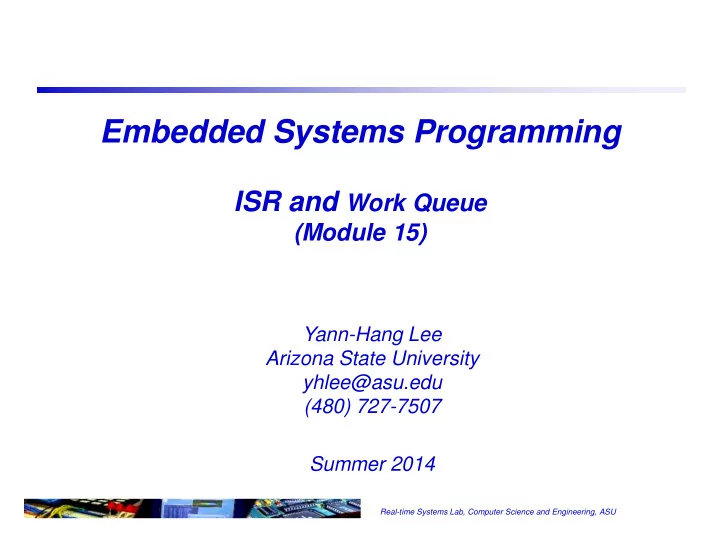

Embedded Systems Programming ISR and Work Queue (Module 15) Yann-Hang Lee Arizona State University yhlee@asu.edu (480) 727-7507 Summer 2014 Real-time Systems Lab, Computer Science and Engineering, ASU
Interrupt Handling Depends on the type of interrupts I/O interrupts Timer interrupts Interprocessor interrupts Unlike exceptions, interrupts are “out of context” events Generally associated with a specific device that delivers a signal on a specific IRQ IRQs can be shared and several ISRs may be registered for a single IRQ ISRs is unable to sleep, or block Critical: to be executed within the ISR immediately, with maskable interrupts disabled Noncritical: should be finished quickly, so they are executed by theISR immediately, with the interrupts enabled Noncritical deferrable: deferrable actions are performed by means of separate functions 1 Real-time Systems Lab, Computer Science and Engineering, ASU
I/O Interrupt Handling SOFTWARE HARDWARE (Interrupt Handler) Device 1 Device 2 IRQn common_interrupt: INT IDT[32+n] SAVE_ALL movl %esp, %eax PIC IRQn_interrupt() call do_IRQ jmp ret_from_intr do_IRQ(n) Interrupt service Interrupt service routine 1 routine 2 (D. P. Bovet and M. Cesati, “Understanding Execute ISRs associated with all the devices the Linux Kernel”, 3rd Edition) that share the IRQ. 2 Real-time Systems Lab, Computer Science and Engineering, ASU
Why ISR Bottom Half? To have low interrupt latency -- to split interrupt routines into a `top half', which receives the hardware interrupt and a `bottom half', which does the lengthy processing. Top halves have following properties (requirements) need to run as quickly as possible run with some (or all) interrupt levels disabled are often time-critical and they deal with HW do not run in process context and cannot block Bottom halves are to defer work later “Later” is often simply “not now” Often, bottom halves run immediately after interrupt returns They run with all interrupts enabled Code in the Linux kernel runs in one of three contexts: Process context, kernel thread context, and Interrupt. 3 Real-time Systems Lab, Computer Science and Engineering, ASU
A World of Bottom Halves Multiple mechanisms are available for bottom halves softirq: (available since 2.3) A set of 32 statically defined bottom halves that can run simultaneously on any processor Even 2 of the same type can run concurrently Used when performance is critical Must be registered statically at compile-time tasklet: (available since 2.3) Are built on top of softirqs Two different tasklets can run simultaneously on different processors But 2 of the same type cannot run simultaneously Used most of the time for its ease and flexibility Code can dynamically register tasklets work queues: (available since 2.5) Queueing work to be performed in process context 4 Real-time Systems Lab, Computer Science and Engineering, ASU
WorkQueues To request that a function be called at some future time. tasklets execute quickly, for a short period of time, and in atomic mode workqueue functions may have higher latency but need not be atomic Run in the context of a special kernel process (worker thread) more flexibility and workqueue functions can sleep. they are allowed to block (unlike deferred routines) No access to user space A workqueue ( workqueue_struct) must be explicitly created Each workqueue has one or more dedicated “kernel threads”, which run functions submitted to the queue via queue_work() . work_struct structure to submit a task to a workqueue DECLARE_WORK(name, void (*function)(void *), void *data); The kernel offers a predefined work queue called events , which can be freely used by every kernel developer 5 Real-time Systems Lab, Computer Science and Engineering, ASU
Example of Work Structure and Handler #include <linux/kernel.h> #include <linux/module.h> #include <linux/workqueue.h> MODULE_LICENSE("GPL"); static struct workqueue_struct *my_wq; // work queue typedef struct { // work struct work_struct my_work; int x; } my_work_t; my_work_t *work, *work2; static void my_wq_function( struct work_struct *work) // function to be call { my_work_t *my_work = (my_work_t *)work; printk( "my_work.x %d\n", my_work->x ); kfree( (void *)work ); return; } (http://www.ibm.com/developerworks/linux/library/l-tasklets/index.html) 6 Real-time Systems Lab, Computer Science and Engineering, ASU
Example of Work and WorkQueue Creation int init_module( void ) { int ret; my_wq = create_workqueue("my_queue"); // create work queue if (my_wq) { work = (my_work_t *)kmalloc(sizeof(my_work_t), GFP_KERNEL); if (work) { // Queue work (item 1) INIT_WORK( (struct work_struct *)work, my_wq_function ); work->x = 1; ret = queue_work( my_wq, (struct work_struct *)work ); } work2 = (my_work_t *)kmalloc(sizeof(my_work_t), GFP_KERNEL); if (work2) { // Queue work (item 2) INIT_WORK( (struct work_struct *)work2, my_wq_function ); work2->x = 2; ret = queue_work( my_wq, (struct work_struct *)work2 ); } } return 0; } (http://www.ibm.com/developerworks/linux/library/l-tasklets/index.html) 7 Real-time Systems Lab, Computer Science and Engineering, ASU
Linux Kernel Thread A way to implement background tasks inside the kernel static struct task_struct *tsk; static int thread_function(void *data) { int time_count = 0; do { printk(KERN_INFO "thread_function: %d times", ++time_count); msleep(1000); }while(!kthread_should_stop() && time_count<=30); return time_count; } static int hello_init(void) { tsk = kthread_run(thread_function, NULL, "mythread%d", 1); if (IS_ERR(tsk)) { …. } } 8 Real-time Systems Lab, Computer Science and Engineering, ASU
Recommend
More recommend